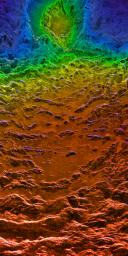Looking Westward Across the Fortuna Tessera (Left Member of a Synthetic Stereo Pair)
Caption:
This perspective view of Venus, generated by computer from Magellan data and color-coded with emissivity, is a look westward across the Fortuna Tessera toward the slopes of Maxwell Montes. The tessera terrain of both Fortuna and the slopes of Maxwell is characterized by roughly parallel north-south trending ridges. With a maximum elevation of roughly 11 km above the planetary reference surface (which has a radius of 6051 km), Maxwell is the highest mountain on Venus. The circular feature on the slope of Maxwell is the crater Cleopatra, which has a diameter of approximately 100 km. Before the high-resolution Magellan images were available, Cleopatra was thought to be a volcanic feature because of its mountainous location and the lava flow visible emanating from the crater and flooding the troughs of the foreground terrain. The Magellan images, however, clearly show an ejecta blanket characteristic of an impact origin around Cleopatra. Other Venusian craters have associated outflow features, but these do not resemble the flow from Cleopatra. The difference may be the result of unique target conditions (high elevation, and perhaps high subsurface temperatures if Maxwell is still actively being supported by activity in the interior of Venus), or may simply be the consequence of the formation of the crater on an unusually steep slope. The sides of Maxwell are also characteristically brighter than the lower but otherwise similar foreground terrain because they reflect the microwave signal more efficiently; various hypotheses have been advanced to account for this increased reflectivity and corresponding decreased emissivity (indicated by the blue color). This image is the left member of a synthetic stereo pair; the other image is PIA00316. To view the region in stereo, download the two images, arrange them side by side on the screen or in hardcopy, and view this image with the left eye and the other with the right. For best viewing, use a stereoscope or size the images so that their width is close to the interpupillary distance, about 6.6 cm (2.6 inches). Magellan MIDR quadrangle* containing this image: F-66N012. Image resolution (m): 75. Size of region shown (E-W x N-S, in km): ~300 x 140 at front. Range of emissivities from violet to red: 0.30 -- 0.90. Vertical exaggeration: 20. Azimuth of viewpoint (deg clockwise from East): 345. Elevation of viewpoint (km): 300. *Quadrangle name indicates approximate center latitude (N=north, S=south) and center longitude (East). This mosaic is not a standard Magellan product, but was created to provide data for the view seen here.
Cataloging Keywords:
| Name |
Value |
Additional Values |
| Target |
Venus |
|
| System |
|
|
| Target Type |
Planet |
|
| Mission |
Magellan |
|
| Instrument Host |
Magellan |
|
| Host Type |
Orbiter |
|
| Instrument |
Imaging Radar |
|
| Detector |
|
|
| Extra Keywords |
Color, Crater, Impact, Mountain, Volcano |
| Acquisition Date |
|
| Release Date |
1998-06-04 |
| Date in Caption |
|
|
| Image Credit |
NASA/JPL/USGS |
| Source |
photojournal.jpl.nasa.gov/catalog/PIA00315 |
| Identifier |
PIA00315 |

